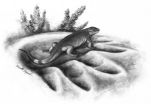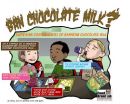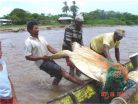(Press-News.org) Six months off may not be long enough for the brains of football players to completely heal after a single season, putting them at even greater risk of head injury the next season.
"I don't want to be an alarmist, but this is something to be concerned about," said Jeffrey J. Bazarian, M.D., associate professor of Emergency Medicine at the University of Rochester School of Medicine and Dentistry and lead author of the study, published in PLOS ONE.
"At this point we don't know the implications, but there is a valid concern that six months of no-contact rest may not be enough for some players," he said. "And the reality of high school, college and professional athletics is that most players don't actually rest during the off-season. They continue to train and push themselves and prepare for the next season."
Bazarian investigated the brains of 10 Division III University of Rochester football players before the start of the 2011 season, at the conclusion of the season, and after six months of no-contact rest. All took part in daily practices and weekly games, but none of them suffered a concussion.
Imaging scans showed changes consistent with mild brain injury in about half of the players six-months after the season ended, despite the fact that no one had a concussion. Brain changes in the football players were compared to a control group of five college students who didn't play contact sports.
The new data also suggest that inflammation may be a key factor in whether players recovered within six months. Levels of inflammatory markers present in a player's blood sample correlated with a lack of complete brain recovery.
"What is an adequate rest period? We don't know. Six months may be enough for some players but not for others," Bazarian said. "The autoimmune response and inflammation we observed in the blood of players who didn't recover could be a result of genetics, diet, or other factors, but it was not the result of a concussion, since none of the athletes suffered one."
Bazarian noted that his goal is not to derail football, but to make the sport safer. One idea that has been proposed by organizations such as the Sports Legacy Institute is to implement a system similar to the pitch count used in baseball. In football, this would mean identifying a threshold number of head hits of a certain force – above which the brain is likely to develop white matter changes consistent with injury, and removing players from the game once they reach that threshold.
Some in the field have also proposed that no child under the age of 14 should have head contact in football, Bazarian said, and the National Collegiate Athletic Association or NCAA is considering a limit of two contact-practices a week.
The UR college players who participated in the study wore accelerometers mounted inside their helmets, which were provided by Riddell, a leading manufacturer of football equipment. Researchers were able to track every hit, from seemingly light blows in practice to the most dangerous type of hit – a bobble head phenomenon known as rotational acceleration. They found that the players sustained between 431 and 1,850 head blows in the single football season, none of which resulted in a concussion.
Investigators observed brain changes with advanced technology called diffusion tensor imaging (DTI), which is similar to an MRI scan. They also measured changes with standard balance and cognitive tests and blood tests.
Bazarian's analysis revealed that white matter changes in the players' brains started to look different from the control group when players experienced as few as 10 to 15 head impacts with a rotational acceleration that exceeded 6000 rads/sec2. For reference, when a person nods his head up and down as fast as possible, this produces a rotational acceleration of approximately 180 rads/sec2.
Future studies are needed, and already a follow-up project is underway to focus on inflammation. Ten additional football players were added to the 2011 data, for a total of 20 players plus the five controls. In collaboration with researchers from Harvard Medical School and the Cleveland Clinic, Bazarian's group is analyzing inflammatory markers in the blood of the players and comparing them to the DTI images.
INFORMATION:
The PLOS ONE study was supported by funds from the National Football League Charities. The funders had no role in study design, data collection and analysis, decision to publish or preparation of the manuscript. Bazarian disclosed that he has a patent pending for a new method to diagnose mild brain injury and that he is a consultant to Banyan Biomarkers.
In addition to Bazarian, Tong Zhu, Jianhui Zhong, Eric Rozen, Andrew Roberts, Kian Merchant-Borna, Beau Abar and Eric G. Blackman from the University of Rochester contributed to the research. Damir Janigro from the Cleveland Clinic Lerner Research Institute and Hannah Javien from Hamilton College participated as well.
Off-season doesn't allow brain to recover from football hits, study says
2014-04-17
ELSE PRESS RELEASES FROM THIS DATE:
Earliest ancestor of land herbivores discovered
2014-04-17
New research from the University of Toronto Mississauga demonstrates how carnivores transitioned into herbivores for the first time on land.
"The evolution of herbivory was revolutionary to life on land because it meant terrestrial vertebrates could directly access the vast resources provided by terrestrial plants," says paleontologist Robert Reisz, a professor in the Department of Biology. "These herbivores in turn became a major food resource for large land predators."
Previously unknown, the 300-million-year old fossilized juvenile skeleton of Eocasea martini is ...
Banning chocolate milk backfires
2014-04-17
ITHACA, N.Y. – To some, banning chocolate milk from elementary schools seemed like a good idea, but new Cornell University research shows that removing chocolate milk from school menus has negative consequences.
"When schools ban chocolate milk, we found it usually backfires. On average, milk sales drop by 10 percent, 29 percent of white milk gets thrown out, and participation in the school lunch program may also decrease," reports Andrew Hanks, lead author and research associate Cornell's Dyson School of Applied Economics and Management. "This is probably not what parents ...
Researchers see hospitalization records as additional tool
2014-04-17
MEDFORD/SOMERVILLE, Mass. – Comparing hospitalization records with data reported to local boards of health presents a more accurate way to monitor how well communities track disease outbreaks, according to a paper published April 16 in the journal PLOS ONE by a research team led by Elena Naumova, Ph.D., professor of civil and environmental engineering and associate dean at Tufts University School of Engineering.
In a paper titled "Hospitalization Records as a Tool for Evaluating Performance of Food and Water-Borne Disease Surveillance Systems: A Massachusetts Case Study," ...
The surprising consequences of banning chocolate milk
2014-04-17
VIDEO:
Director of the Cornell Food and Brand Lab, Brian Wansink recommends, "There are other ways to encourage kids to select white milk without banning the chocolate. Make white milk appear...
Click here for more information.
For many children eating school lunch, chocolate milk is a favorite choice. What would happen if chocolate milk were banned from school cafeterias? "Students take 10% less milk, waste 29% more and may even stop eating school meals," says Andrew Hanks, ...
Family ties in the language jungle
2014-04-17
This news release is available in German. The only linguistic data available for Carabayo, a language spoken by an indigenous group that lives in voluntary isolation, is a set of about 50 words. This list was compiled in 1969 during a brief encounter with one Carabayo family. Frank Seifart of the Max Planck Institute for Evolutionary Anthropology in Leipzig, Germany, and Juan Alvaro Echeverri of the Universidad Nacional de Colombia in Leticia, Colombia, have now analysed this historical data set and compared it with various languages (once) spoken in the region. The ...
High disease load reduces mortality of children
2014-04-17
This news release is available in German. Children who have been conceived during a severe epidemic are more resistant against other pathogens later in life. For the first time this has been proved by researchers at the Max Planck Institute for Demographic Research (MPIDR) in Rostock, Germany, for the 18th century epidemics of measles and smallpox in the Canadian province of Québec. Children who were conceived during the wave of measles in 1714 and 1715 died significantly less often from smallpox 15 years later than children who had been conceived before the measles ...
Declining catch rates in Caribbean green turtle fishery may be result of overfishing
2014-04-17
A 20-year assessment of Nicaragua's legal, artisanal green sea turtle fishery has uncovered a stark reality: greatly reduced overall catch rates of turtles in what may have become an unsustainable take, according to conservation scientists from the Wildlife Conservation Society and University of Florida.
During the research period, conservation scientists estimated that more than 170,000 green turtles were killed between 1991 and 2011, with catch rates peaking in 1997 and 2002 and declining steeply after 2008, likely resulting from over-fishing. The trend in catch rates, ...
In old age, lack of emotion and interest may signal your brain is shrinking
2014-04-16
MINNEAPOLIS – Older people who have apathy but not depression may have smaller brain volumes than those without apathy, according to a new study published in the April 16, 2014, online issue of Neurology®, the medical journal of the American Academy of Neurology. Apathy is a lack of interest or emotion.
"Just as signs of memory loss may signal brain changes related to brain disease, apathy may indicate underlying changes," said Lenore J. Launer, PhD, with the National Institute on Aging at the National Institutes of Health (NIH) in Bethesda, MD, and a member of the American ...
Dermatologists with access to sample drugs write costlier prescriptions, Stanford study finds
2014-04-16
STANFORD, Calif. — Dermatologists with access to free drug samples are more likely than those without access to samples to write prescriptions for drugs that are more expensive, according to a study by researchers at the Stanford University School of Medicine.
Although studies have shown that most physicians do not believe that the availability of free samples affects their behavior or recommendations for patients, the researchers found that the average retail cost of the prescriptions written by dermatologists with access to samples are about twice the cost of prescriptions ...
Free drug samples can change prescribing habits of dermatologists
2014-04-16
The availability of free medication samples in dermatology offices appears to change prescribing practices for acne, a common condition for which free samples are often available.
Free drug samples provided by pharmaceutical companies are widely available in dermatology practices.
The authors investigated prescribing practices for acne vulgaris and rosacea. Data for the study were obtained from a nationally representative sample of dermatologists in the National Disease and Therapeutic Index (NDTI), a survey of office-based U.S. physicians, and from an academic medical ...



